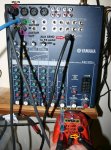Thanks. Am skipping about - but it's because i'm skipping between mixers. Can stick with the MG102c now because it gets me FX on the mic, leaving the guitar clean.
What's the point of those built-in FX on the other mixer if they bleed thro to all the other channels, despite the other FX knobs set to zero? That is so limiting. Why not have individual FX on each channel, or just one FX channel insulated from the others?
But is my current pedal set-up ok though? Surely the FX should or could be replugged (looped?) to the mixer so that you could monitor what's going on thro the mixer headphone socket? I mean. not everyone is going to be plugging to a digital interface where you can also attach phones for monitoring?
Okay, here's what I would do (read carefully and do this one step at a time):
Connect the Aux out of the board to the input of the pedal and the output of the pedal to the Left/Mono of channel 3 (or whatever open Left/Mono input you've got). Pan everything center, or as desired. Turn the Aux knob on the mic channel up and all the other ones down.
That will allow you to do a mix for live use or to listen to in headphones. This is the normal configuration of a mixer like that.
Pick up a pair of insert tap cables*. They are a specialty cable with TRS (like a headphone plug) on one end and TS (like a guitar cable plug) on the other. You plug the TRS end into the mixer insert and the TS end into the interface. (*You can cheat and partially insert a standard guitar cable to the "first click". This works well with some insert jacks and not well with others. Try it.)
Now you'll be able to record guitar and vocal (or anything plugged into channels 1 and 2) dry, which is nice because you can do a better job with your vocal effects after recording. You'll still be able to hear your effects live.
Finally, connect the line outputs of the interface to a stereo channel on the mixer.
That will let you hear playback from the computer in headphones connected to the mixer. You can even record an additional part to something that's already recorded by doing this. In fact, you could record a drum part first and then record your vocal and guitar.
If you ever want to record your mix instead of the two separate inputs connect the mixer Rec Out, instead of the inserts, to the interface inputs.



